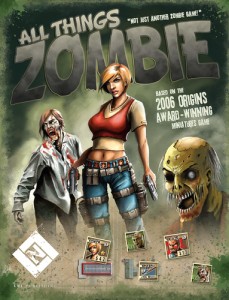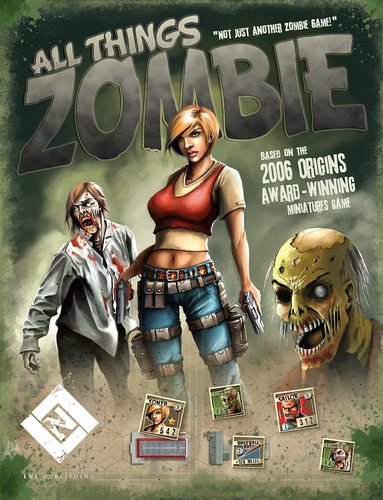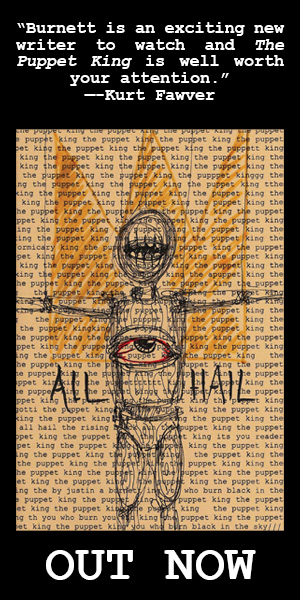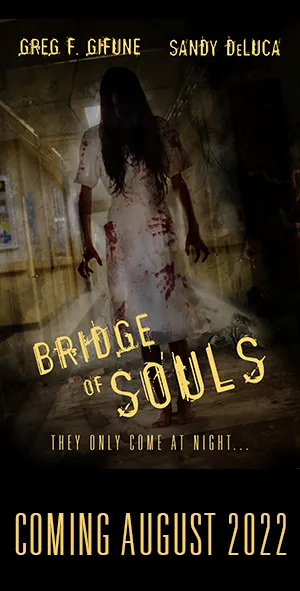
Okay, I’m probably being unfairly silly. It’s a bad habit I need to break. Putting that aside for now: All Things Zombie, by Lock ‘n Load publishing, is based on an award-winning miniatures game that, obviously, takes place during the zombie apocalypse. It’s also one of the most unique war games I’ve ever played.
Granted, I have to admit that I’m not the most avid wargamer out there by any stretch, but I have dabbled in it a little. While I can see the appeal of the genre, most of the time it’s just not for me. I usually lack the patience for those kinds of a games. That just makes it all the more impressive at how pleasantly surprised I was by this game.
First off: the components: There are two double-sided game boards. Both are really solid, I’d hesitate to even call them cardboard, though I believe that’s what they are. I don’t think they’re actually any thicker than your usual boards, but they seem sturdier somehow. The maps fit together, short sides to short sides or long sides to long sides, to allow for larger maps. However, with a total of only four maps on two boards the modularity is somewhat limited, and you’ll become familiar with all of the layouts. Next, you’ve got a some cards in a nice solid card stock. Keep ’em away from your eyes though, the corners are sharp. There are some large character cards, also made from card stock, and all of the other game components are small cardboard counters. They’re nice and thick considering how small they are. Keep a lot of small sandwich bags on hand; not only are there a lot of counters, there is a large variety of counters for different parts of the game, from the zombies and characters to the weapons to all the other necessary components. You don’t want to have to unnecessarily dig through a big pile of different kinds of tokens figuring out which is what. My one complaint with the weapons and other tokens is that I’m calling BS on how many weapons there are to find. You have to search buildings, like homes and restaurants and other public buildings, to find weapons (and other equipment) and yet pistols and assault rifles are relatively plenty, but there’s only one baseball bat to be found? I mean, sure, according to the campaign included in the rule book this takes place in America, but I’m pretty sure that baseball bats are still a lot more common than assault rifles and P-90s. You can even find a grenade for crying out loud. I’m sorry, but it’s a weird town that has as many privately-owned hand grenades as baseball bats, even in the U.S. Having played the game, I definitely understand the need for the guns. I can maybe even understand the need to keep bats scarce for balance issues. But it’s a little difficult for me to suspend my disbelief with so few. Just sayin’.
The art for this game runs from average to amazing. The art on all of the tokens, the portraits, the weapons, the items, etc. is all fairly average. It’s nothing amazing, but it’s far from ugly and it more than gets the job done. The game boards however, are simply beautiful. They’re clear, crisp, and it’s very easy to figure out what’s supposed to be what. It’s not fancy, yet it still has an incredible attention to detail I wouldn’t think you could get from a top-down bird’s eye view. The hexes are clearly marked and highly visible, yet they don’t get in the way of the rest of the visuals and you hardly notice them until you need to. I’m impressed.
Now here is when I would normally try to give a fairly in-depth look at the basics of the rules. With ATZ though… I’m going to have to just barely skim over the rules, because otherwise I might as well just re-print the rulebook, which I don’t think would be covered by fair use. The rules are fairly complex. You see, as I stated before, this isn’t just any old board game: this is a war game. No, you’re not controlling armies or tanks or anything, just some survivors trying not to get overwhelmed by hordes of zombies. But the way the game plays out feels a lot like a war game. Initiative, line of sight, terrain type, and combat bonuses all play a huge part in the strategy and tactics you’ll use.
The rulebook itself is very well laid out. It’s has a nice, well-labeled numbering system based on the rules rather than page number, to allow easier cross-referencing. That is, if you need to look up a rule, and you know it’s in section 4, it’s much easier to find out that the rule is under 4.3 than having to re-read all of page 10 over again. People who aren’t used to looking things up this way might find it a bit strange at first, but you’ll soon learn to appreciate it because you will be looking things up often.
Now, the first thing you need to understand is that ATZ is actually pretty flexible. The rules are for the most part just a skeleton that you wrap different scenarios and campaigns around. While the rulebook does include a pre-generated campaign (a pretty good one, I might add) the game is set up so that you can easily create your own scenarios with whatever goals and challenges you want. The game can be played solo, co-op, or competitively. There is no specific goal for every game, no particular way things must be set up every time… It all depends on the scenario.
Now, three paragraphs into talking about the rules, I’m finally going to describe the rules. Well, the most basic and important ones at least. There are three things you will need to understand in order to play the game. Once you get these the rest should be pretty easy. First is the character and weapon statistics. All characters, zombies included, have three stats: Movement, reputation, and number of melee attacks. Movement and number of melee attacks are self explanatory. Reputation is essentially initiative and any other necessary stat added together; it helps decide who gets to move first, how well you do at shooting and in melee, etc. Also, some characters are special, if they have a star on their token that means they are a… well… a Star character. They get to do special things that I will cover later.
The next thing you need to know is that ATZ has a very unique system for choosing turn order. At the beginning of each turn you roll a die for each player and one for the zombies (zombies are always controlled by the game, so someone needs to roll for them). The person to roll highest goes first. However, any characters you have with a rep lower than the number you rolled don’t get to go. So, much like The Price is Right, you want to get closest to the target number without going over. This does mean that it’s possible for someone, or even everyone, including the zombies, to miss a turn. Believe me when I say, it really, really sucks when you miss your turn and the zombies don’t. Now, Stars generally have a pretty high rep, which means that they don’t miss their turn often. An added bonus is that if a Star takes their turn, any of your non-Star characters who begin the turn next to that Star also get to take a turn, even if they normally wouldn’t. Now, taking a turn is called getting your “impulse” phase, which consists of being able to move and take one of several different actions. I assume they call it an impulse phase because it is possible for your characters to take certain actions without getting an impulse. This leads us into…
…the third thing that you must know about: Reactions tests. Much of the action in the game revolves around taking reaction tests. Whenever you have a character who 1. Wants to charge into melee combat; 2. Gets charged by zombies or a character; 3. Gets shot at; or 4. Has an enemy character come into their line-of-sight, they must take the respective reaction test. Roll two dice and compare them against the character’s rep. Then follow what the respective table says. (Don’t worry, there’s a very handy player aid card that spells it out for you. The flip side even has everything you need to know about rolling for ranged and melee combat.) With the exception of in-sight reaction tests, Stars will be able to do pick and choose what they want to do, while other survivors will always have to follow the table. Zombies never roll for reactions tests. When they move, they pretty much always just head strait for the nearest character and try to enter melee combat.
Now, keep in mind, like I said earlier, these are the three things you must know, but you still really, really need to read the rule book because there is a lot more to the game.
So, how does it play? First let me say, this game is actually fun to play solo. With most games that include a solo option, I find that they usually seem kind of tacked-on and they don’t really add anything to the game. With ATZ, it’s almost as if the game was intended to originally be a single player/co-op game and then they figured that people might like some competitive play as well, so they then took some time and worked on including that too. Solo, co-op, and competitive are all equally fun, which really surprised and impressed me. However, you also need to know that ATZ is hard. You’ll find out rather quickly that it pays to be patient in this game. It took me three games of trying to rush the objectives of the first scenario to find out that that’s a pretty quick way of spawning a lot of zombies fast. Looking around a few forums, I found that’s the same mistake a lot of newbies make. You see, when you enter a building, there are always a random number of zombies inside. Sure, it could be zero, but it could also be five or six, which is a lot for a survivor to take on alone. You can get swarmed very fast if you’re not paying attention. Which I wasn’t, and I did. This is compounded by the fact that the only reliable way of killing zombies in large enough numbers to matter is the use your guns, which have a chance of spawning more zombies with the noise they make.
Beyond that, it’s hard to say anything beyond “it’s a fun game.” I mean, the variability from game to game means it’s somewhat different each time you play. Which, it should go without saying, means that the game has a lot of replayability. A simple scenario can be played in half an hour or less, while a more complicated scenario with two or more players could potentially take a couple hours or longer. You can have something as simple as “search X number of houses and then escape to this place” or “kill all of the enemy survivors” to things as complex as “survive X number of waves of zombie attacks” and “get from point A to point B, rescue the trapped survivor, escort them to safety, all the while searching buildings for a specific item.” You’re really only limited by your imagination. I seriously suggest playing the campaign included in the rule book to get a taste for just how flexible the scenario creation can be.
I will say that if you dislike too much dice rolling, you’ll probably end up fatigued after a while. You roll for turn order, you roll for reaction tests, you roll for combat, you roll to see if you spawned more zombies, and so on… You draw cards to see how many zombies are inside a building instead of rolling dice, and that helps a little, but in the end there are a lot of dice rolls. This is no problem for wargamers really, but more casual gamers might not be used to it. The game seems to be somewhat sparse in terms of what’s in the box. While I would say it’s sufficient overall, I kind of would like to have some more pre-generated characters, as well as more tokens for the weapons (especially melee weapons) or even more kinds of weapons. I understand why there aren’t more weapons, most of that ones they already include have at least one special rule unique to it, and it can’t be easy to come up with a bunch of balanced, unique rules. But still… variety is the spice of life, and especially in a game like this, I want more variety.
Bottom Line: I cautiously recommend this game. It is definitely not for the casual gamer. The complex mechanics will be very off-putting to anyone not expecting them. However, wargamers and other hardcore gamers will most definitely get more than their money’s worth. If you’re more than a casual gamer but not quite a hardcore gamer… well… that’s when it’s a tough call. If you like zombies, (and why would you be at this website if you don’t?) then it’s likely a safe call and you’ll probably like this game. Just know that’s it’s a bit more complicated than most of the games you’re used to. I like this game; it’s fun. While I don’t think the game is perfect, in the end my biggest complaint is that I want more of the game than what comes in the box. And that’s not really a bad complaint. To my knowledge Lock N Load Publishing doesn’t have any expansions for the game planned, which is a shame. But hopefully they’ll come out with some in the future.







Just admit that you loved this game, man!